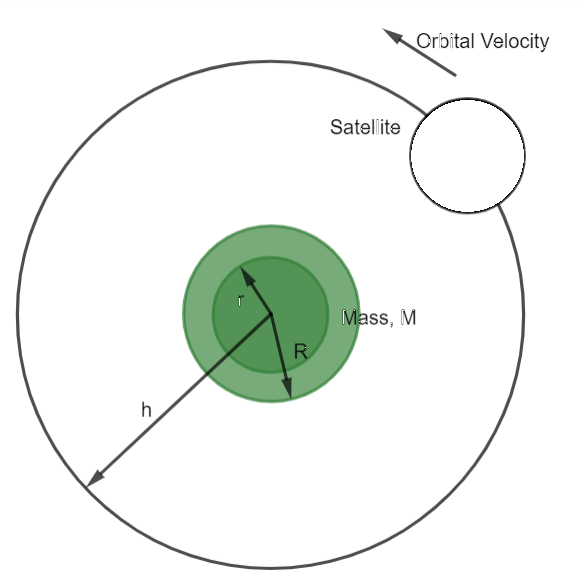
Define orbital velocity of a satellite.
Answer
509.1k+ views
Hint: Orbital velocity as the name suggests has to be a physical quantity that represents velocity, i.e., speed with an associated direction. Satellites are objects/bodies in space that orbit or circles around a bigger object/ body. Thus orbital velocity might be a physical quantity that represents the speed of a satellite around another special body in a particular direction.
Complete answer:
An object in an orbit that revolves around another object is called a satellite. A satellite can be a natural celestial body, like Earth or the moon. Otherwise it can be a manmade satellite.
An orbit is a circular or elliptical path which may or may not be repeating in nature. This path is depicted by an imaginary line around an object on which another object (satellite) revolves. To resolve, it requires rapidity with respect to its position, or in other words it requires velocity. This velocity of an astronomical body is the required by it to revolve around the orbit of another object is known as the orbital velocity. Without the precise orbital velocity the satellite will not be able to maintain the balance between its inertia and gravity of the massive body.

Orbital Velocity is expressed in meters per second (m/s).
The Orbital Velocity’s formula is given as:
where, G=Gravitational Constant
M=Mass of the body being revolved
R= Radius of the Orbit.
Additional Information:
(i) According to Newton's laws of motion all periodic orbits are ellipses.
(ii) Mercury has the highest orbital velocity in our solar system.
(iii) Earth's orbit is not a perfect circle. It is elliptical, or slightly oval-shaped.
(iv) Centripetal Force is needed to balance the satellite’s inertia on an orbit.
(v) The orbital velocity of the satellite depends on its altitude above Earth.
Note: Mass of the orbiting body (Satellite) does not affect the orbital velocity. Orbital velocity cannot be calculated without the radius of orbit and the Mass of the central body.
Complete answer:
An object in an orbit that revolves around another object is called a satellite. A satellite can be a natural celestial body, like Earth or the moon. Otherwise it can be a manmade satellite.
An orbit is a circular or elliptical path which may or may not be repeating in nature. This path is depicted by an imaginary line around an object on which another object (satellite) revolves. To resolve, it requires rapidity with respect to its position, or in other words it requires velocity. This velocity of an astronomical body is the required by it to revolve around the orbit of another object is known as the orbital velocity. Without the precise orbital velocity the satellite will not be able to maintain the balance between its inertia and gravity of the massive body.

Orbital Velocity is expressed in meters per second (m/s).
The Orbital Velocity’s formula is given as:
where, G=Gravitational Constant
M=Mass of the body being revolved
R= Radius of the Orbit.
Additional Information:
(i) According to Newton's laws of motion all periodic orbits are ellipses.
(ii) Mercury has the highest orbital velocity in our solar system.
(iii) Earth's orbit is not a perfect circle. It is elliptical, or slightly oval-shaped.
(iv) Centripetal Force is needed to balance the satellite’s inertia on an orbit.
(v) The orbital velocity of the satellite depends on its altitude above Earth.
Note: Mass of the orbiting body (Satellite) does not affect the orbital velocity. Orbital velocity cannot be calculated without the radius of orbit and the Mass of the central body.
Recently Updated Pages
Master Class 11 Economics: Engaging Questions & Answers for Success

Master Class 11 Business Studies: Engaging Questions & Answers for Success

Master Class 11 Accountancy: Engaging Questions & Answers for Success

Master Class 11 English: Engaging Questions & Answers for Success

Master Class 11 Computer Science: Engaging Questions & Answers for Success

Master Class 11 Maths: Engaging Questions & Answers for Success

Trending doubts
State and prove Bernoullis theorem class 11 physics CBSE

1 ton equals to A 100 kg B 1000 kg C 10 kg D 10000 class 11 physics CBSE

State the laws of reflection of light

One Metric ton is equal to kg A 10000 B 1000 C 100 class 11 physics CBSE

1 Quintal is equal to a 110 kg b 10 kg c 100kg d 1000 class 11 physics CBSE

Difference Between Prokaryotic Cells and Eukaryotic Cells




